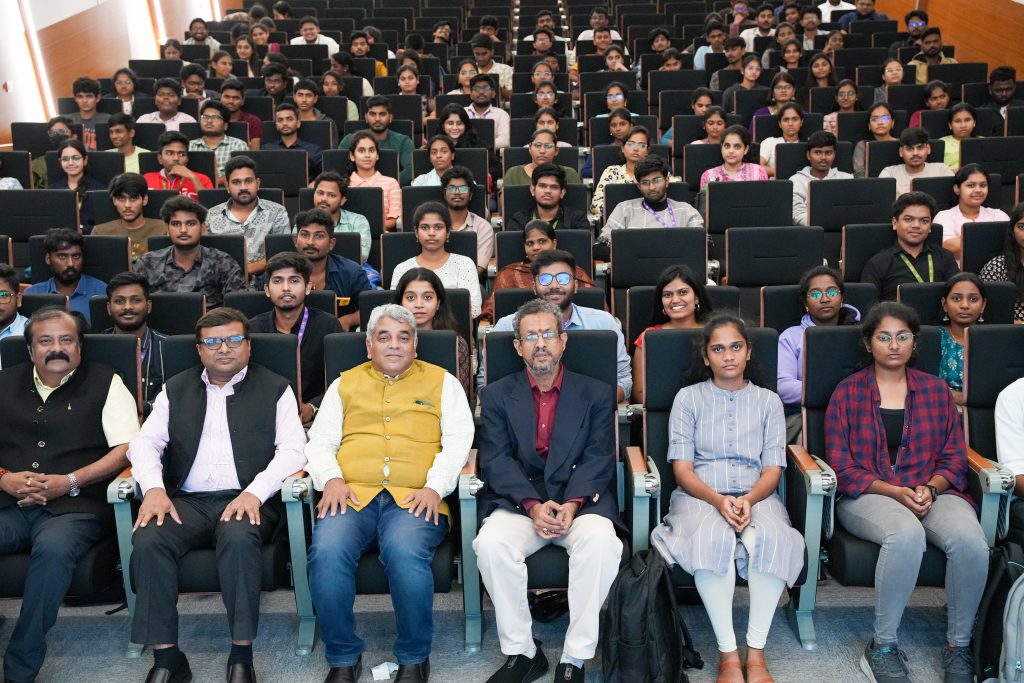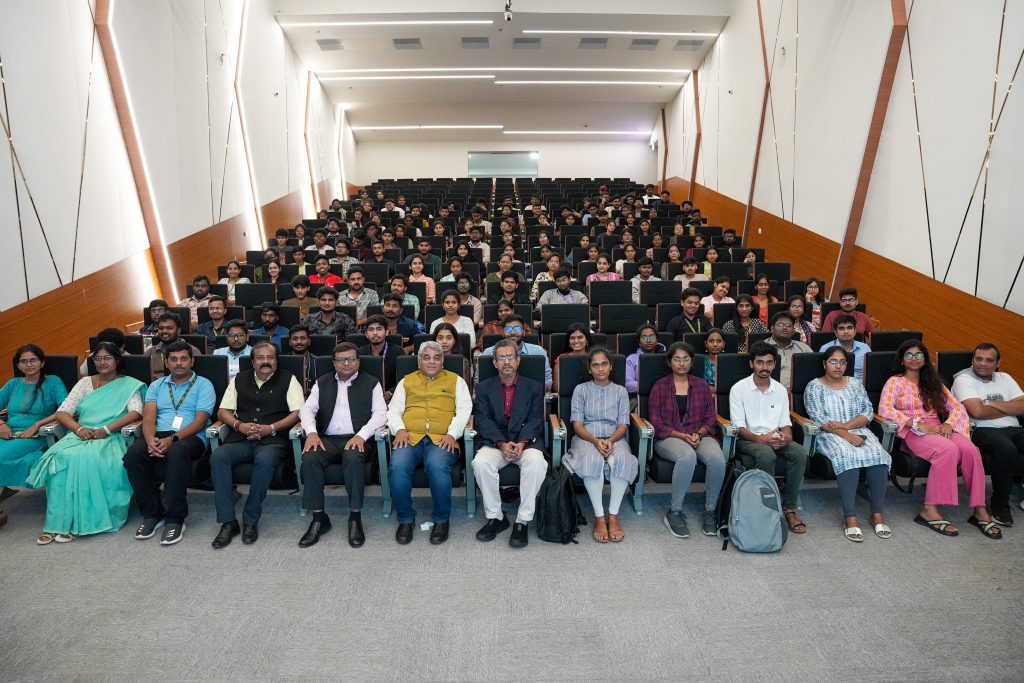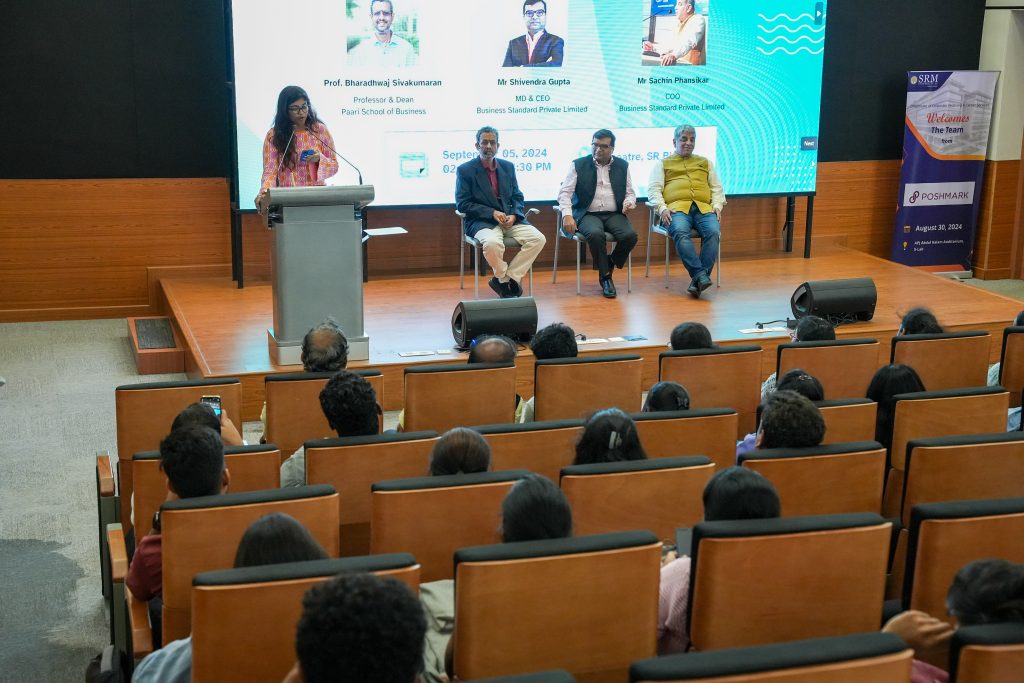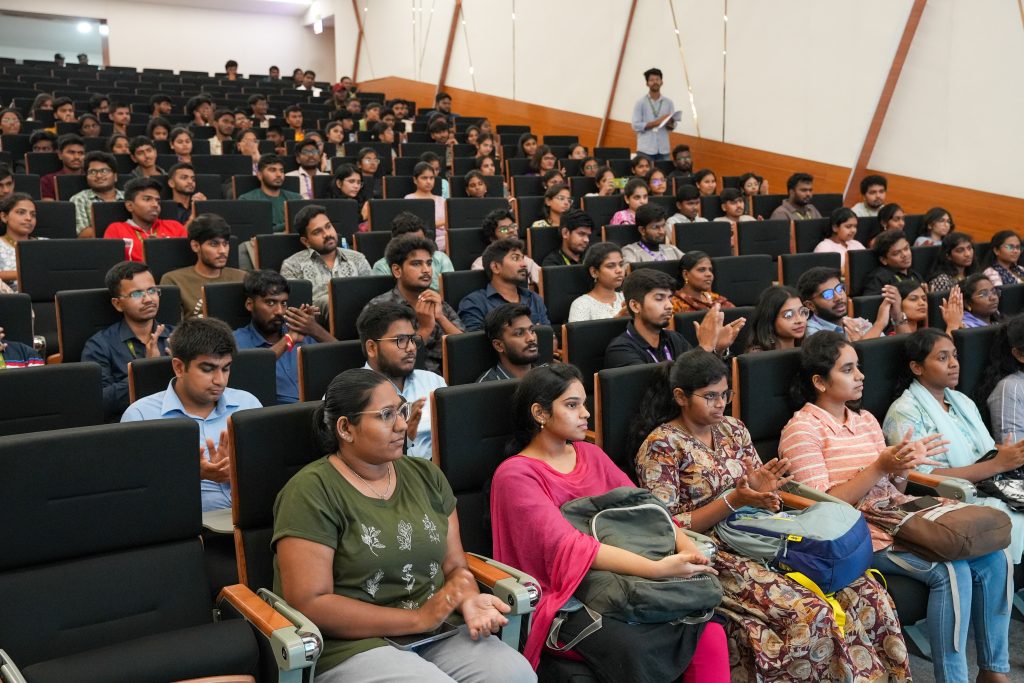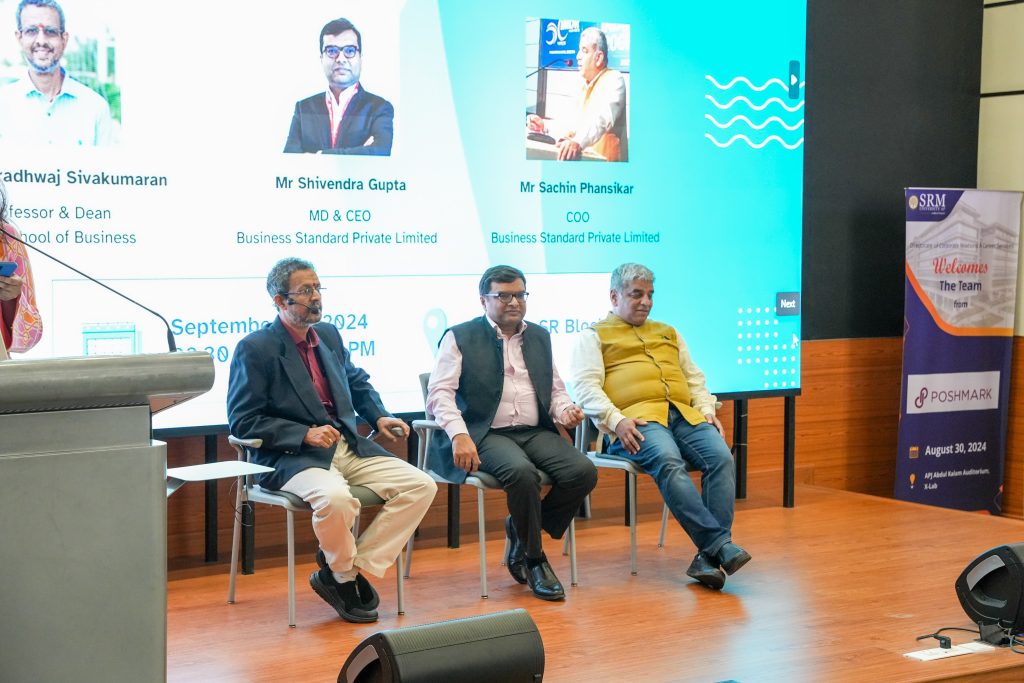SRM-AP All News
ALL News
- SRM AP’s Hatchlab Research Centre Selected as Implementation Agency for GENESIS Scheme September 25, 2024
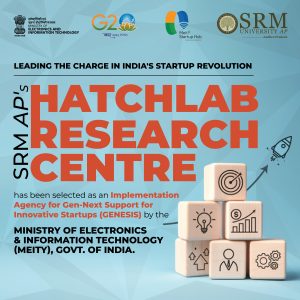 The Directorate of Entrepreneurship and Innovation is thrilled to announce that the Hatchlab Research Centre (HRC), the Technology Business Incubator at SRM University-AP, has been chosen as the Implementation Agency for the “Gen-Next Support for Innovative Startups (GENESIS)” initiative. This decision, made by the Ministry of Electronics & Information Technology (MeitY), Government of India, marks a significant milestone for HRC and highlights its commitment to fostering innovation and entrepreneurship.
The Directorate of Entrepreneurship and Innovation is thrilled to announce that the Hatchlab Research Centre (HRC), the Technology Business Incubator at SRM University-AP, has been chosen as the Implementation Agency for the “Gen-Next Support for Innovative Startups (GENESIS)” initiative. This decision, made by the Ministry of Electronics & Information Technology (MeitY), Government of India, marks a significant milestone for HRC and highlights its commitment to fostering innovation and entrepreneurship.The GENESIS scheme emerges as a strategic umbrella initiative by MeitY aimed at nurturing and supporting startup ecosystems in Tier II and Tier III cities across India. HRC is among the 50 selected implementation agencies tasked with facilitating this vision, backed by a total budgetary allocation of ₹490 crores. This funding will be instrumental in providing vital resources and infrastructure for startups, ensuring they have the necessary support to thrive in a competitive landscape.
Prof. Sidharth Shankar Tripathy, Director of Entrepreneurship & Innovation of SRM AP, said, ” This announcement is a tribute to the soaring entrepreneurial spirit that is visible among the students, faculty and even the staff of our young entrepreneurial university. What makes this achievement even more special is that it was announced at an appropriate juncture time when SRM University-AP had declared the academic year 2023-24 as the “Year of Entrepreneurship & Innovation.With this new responsibility, we look forward to contributing to the success of startups and innovators across India!”
The HRC’s selection comes at a fortuitous time, as SRM University-AP has declared the 2023-24 academic year to be the “Year of Entrepreneurship & Innovation.” This initiative aims to foster a culture of creativity and entrepreneurial spirit among students, providing them with the tools and support needed to transform their ideas into viable business ventures.
The GENESIS scheme is designed to enhance the startup ecosystem in smaller cities, enabling entrepreneurs outside of metropolitan areas to access essential services, mentorship, and funding opportunities. By selecting HRC as an implementation partner, MeitY acknowledges the centre’s potential to drive impactful change and support innovative startups in the region.
As HRC embarks on this new journey, it promises to create a robust framework that encourages collaboration, knowledge sharing, and the development of sustainable business models among emerging entrepreneurs. The centre will facilitate various programs, workshops, and resources designed to equip startups with the skills, network, and funding requisite for success.
With this prestigious recognition, SRM University-AP’s Hatchlab Research Centre is poised to play a pivotal role in transforming the entrepreneurial landscape, paving the way for a more inclusive and diverse startup ecosystem across the nation.
Continue reading → - From Concept to Reality: The Promising Future of AlN-GDC-HEMT in Electronics September 25, 2024
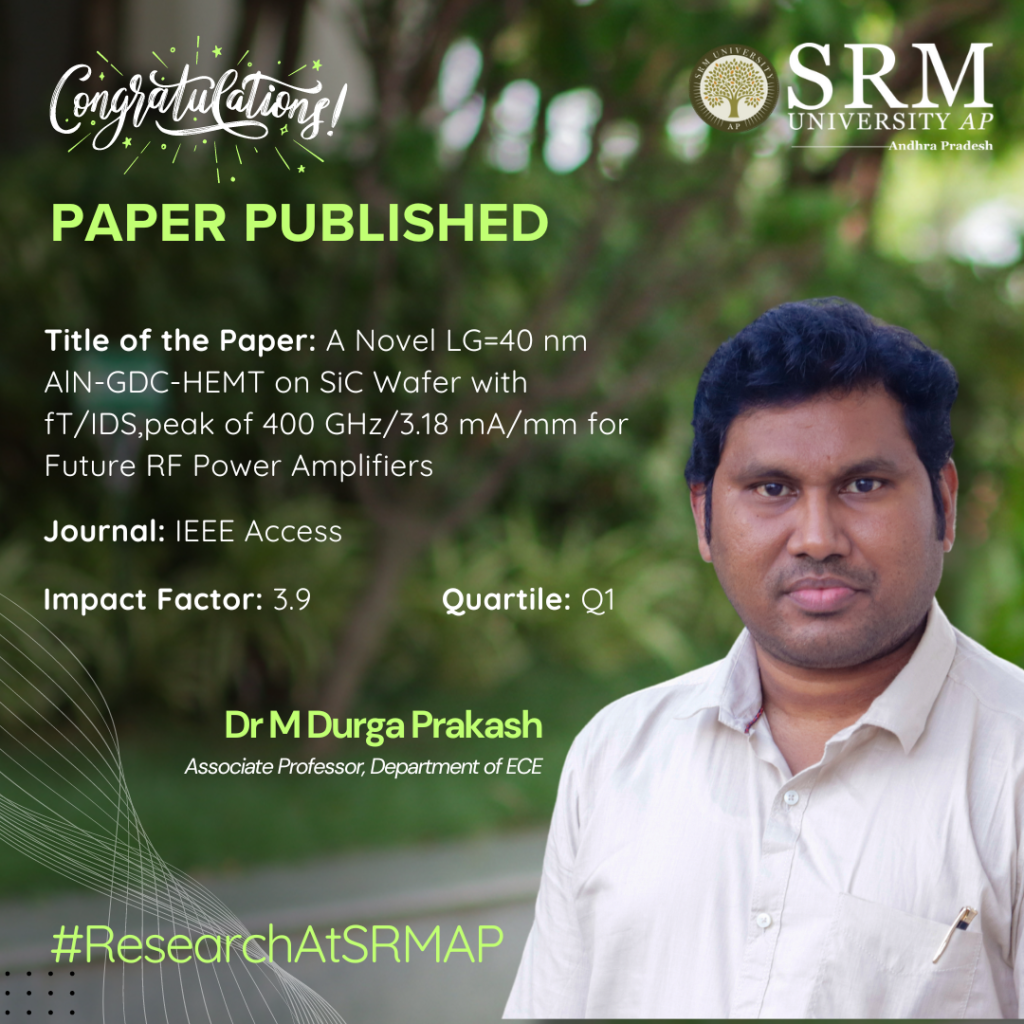
The Department of Electronics and Communication Engineering, SRM University-AP, is pleased to announce that Assistant Professor Dr Durga Prakash has published a noteworthy research paper titled “A Novel LG=40 nm AlN-GDC-HEMT on SiC Wafer with fT/IDS,peak of 400 GHz/3.18 mA/mm for Future RF Power Amplifiers.” This accomplishment reflects Dr Durga Prakash’s expertise and dedication to advancing research in the field and further enriching the academic contributions of the varsity.
Abstract:
This study presents the initial RF/DC performance of innovative AlN/GaN/Graded-AlGaN/GaN double-channel HEMT (AlN-GDC-HEMT) on SiC wafer. Traditional AlGaN/GaN/Graded-AlGaN/GaN double-channel HEMTs (AlGaN-GDC-HEMT) and the AlN-GDC-HEMT are compared. Both devices form two quantum wells, resulting in prominent double peaks in transconductance and cut-off frequency graphs, demonstrating efficient inter-channel communication. AlN-GDC-HEMT and AlGaN-GDC-HEMT are compared based on gate recess length (LR) and top barrier thickness. Gate lengths (LG) are also used to study HEMT scaling. Additionally, gate engineering and lateral scaling affect both devices’ DC/RF behaviour. Based on rigorous comparison investigation, the AlN-GDC-HEMT outperforms the AlGaN-GDC-HEMT due to its higher polarization (spontaneous) density and larger bandgap. The optimized AlN-GDC-HEMT with LG = 40 nm, LGS = 250 nm, and LGD = 400 nm has high performance, with transconductance (GM) values of 203.1 and 787.5 mS/mm at two peaks, IDS_peak of 1.97 A/mm, IDS_sat of 3.18 A/mm, and the highest fT of 285.1 and 416.8 GHz from the left and right peaks First-stage results suggest AlN-GDC-HEMTs could be used in future RF power amplifiers.
Practical & Social Implications of the Research:
It can be concluded that the AlN-GDC-HEMT that has been proposed is extremely promising, as it possesses remarkable performance and is appealing for power microwave GaN-based HEMT production. This highlights the fact that it is suitable for a broad variety of high-performance applications.
Collaborations:
Department of ECE, Faculty of Science and Technology (IcfaiTech), ICFAI Foundation for Higher Education Hyderabad, Hyderabad-501203, India.
Future Research Plans:
Novel semiconductor device development
Continue reading →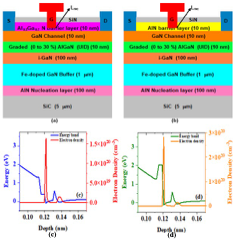
- Dr Barman Decodes the Mysteries of the Universe September 25, 2024
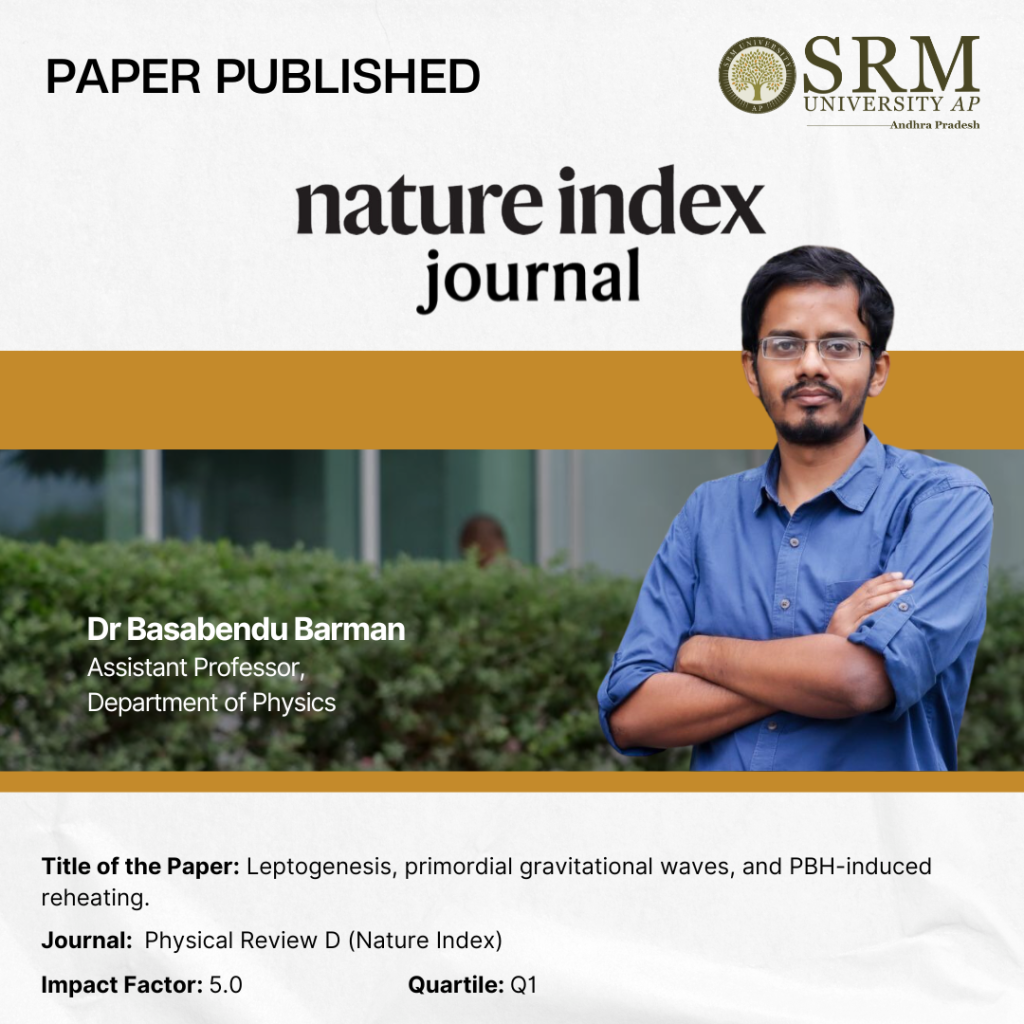
Ever wondered how the universe came into existence? The component with which matter and antimatter were formed? Dr Basabendu Barman, Assistant Professor at the Department of Physics, in his research paper, titled- Leptogenesis, Primordial Gravitational Waves, and PBH-induced Reheating delves into the truth of the formation of matter. Read this exciting paper featured in Physics Review D to learn more!
Abstract:
We explore the possibility of producing the observed matter-antimatter asymmetry of the Universe uniquely from the evaporation of primordial black holes (PBH) that are formed in an inflaton-dominated background. We show it is possible to obtain the desired baryon asymmetry via vanilla leptogenesis from evaporating PBHs of initial mass around 10g. We find that the allowed parameter space is heavily dependent on the shape of the inflaton potential during reheating, the energy density of PBHs, and the nature of the coupling between the inflaton and the Standard Model (SM). To complete the minimal gravitational framework, we also include in our analysis the gravitational leptogenesis set-up through inflaton scattering via exchange of graviton, which opens up an even larger window for PBH mass, depending on the background equation of state. We finally illustrate that such gravitational leptogenesis scenarios can be tested with upcoming gravitational wave (GW) detectors, courtesy of the blue-tilted primordial GW with inflationary origin, thus paving a way to probe a PBH-induced reheating together with leptogenesis.
Practical Implementations & Social Impact:
The first implication lies in the realm of intellect. The question, “Why is the Universe the way it is?” is profoundly significant and has likely intrigued humanity since the dawn of civilization. While technological advancements have allowed us to unravel many of the Universe’s mysteries, we have also come to realize that “what we know is a drop, and what we don’t know is an ocean.” As theoretical particle physicists, our role is to explore this vast ocean of the unknown—a pursuit for which we are rigorously trained. This underscores the vital importance of studying fundamental science. From a practical perspective, our study highlights the crucial role that experiments play in uncovering new knowledge. The synergy between theory and experiment, as we propose, could soon lead to groundbreaking discoveries—or, alternatively, our theory could be disproven if no evidence is found. Either way, it is essential to have advanced experimental facilities and more sensitive detectors to carry out these investigations. This, in turn, calls for increased funding and support for research in the field of high-energy physics.
Collaborations:
India (IIT: Guwahati, Kanpur, Hyderabad; IACS, Kolkata; IOP, Bhubaneswar).
Colombia (Universidad de Antioquia, Universidad de Santiago de Chile).
Abu Dhabi (New York University, Abu Dhabi).
Brazil (IIP, Natal).
Germany (Mainz Institute for Theoretical Physics [MITP], Mainz).
Poland (University of Warsaw).
Spain (Universidad Complutense,Madrid; IFIC, Valencia).
China (T D Lee Institute).
Korea (IBS, Daejeon; KIAS, Seoul; Kyungpook National University, Daegu).
Japan (Hokkaido Univeristy).
France (IJC Lab, Paris).
Sweden (KTH, Stockholm)
US (Washington University, St. Louis; University of Minnesota; Indiana University; University of Pittsburgh, University of Kentucky).Future Plans:
A closer look into early universe dynamics by performing more involved simulations.Connection between particle physics models and early Universe cosmology.Complementary searches from different experiments in unravelling new physics beyond the Standard Model.
Link: https://journals.aps.org/prd/abstract/10.1103/PhysRevD.110.043528
Continue reading →
- Dr Rupesh Kumar Secures Major Research Grant for Amazon Forest Canopy Mapping Project September 24, 2024
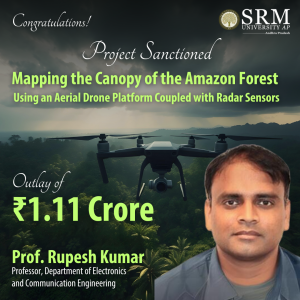 In a groundbreaking development, Dr Rupesh Kumar, a Professor in the Department of Electronics and Communication Engineering, has been awarded a significant project titled “Mapping the Canopy of the Amazon Forest Using an Aerial Drone Platform Coupled with Radar Sensors.” The initiative, funded by the International Peruvian National Research Institute, boasts an impressive outlay of Rs. 1.11 Crores and is set to span over a two-year period.
In a groundbreaking development, Dr Rupesh Kumar, a Professor in the Department of Electronics and Communication Engineering, has been awarded a significant project titled “Mapping the Canopy of the Amazon Forest Using an Aerial Drone Platform Coupled with Radar Sensors.” The initiative, funded by the International Peruvian National Research Institute, boasts an impressive outlay of Rs. 1.11 Crores and is set to span over a two-year period.The project is spearheaded by Principal Investigator Dr Mark Donny Clemente Arenas, an Associate Professor at the National Technological University of South Lima in Peru. This collaboration aims to enhance the understanding of the Amazon’s intricate canopy structure and promote conservation efforts through innovative technology.
In recognition of this notable achievement, SRM University-AP proudly congratulated Dr Kumar and highlighted the significant impact this project could have on environmental research and sustainability. The university’s support underscores its commitment to fostering research initiatives that address global challenges, encouraging faculty members to pursue innovative solutions through collaboration and the application of cutting-edge technology.
This initiative marks a significant milestone in international research collaboration, leveraging technology to address critical environmental challenges in one of the world’s most vital ecosystems.
A Brief Description of the Project
This project facilitates the mapping of the Amazon forest in Peru. An integrated approach of advanced sensors such as LiDAR, Millimeter-Wave Radar, Camera, etc. and UAV will achieve this.
This will help assess the Amazon forest’s health in real time by leveraging the ML/AI approaches.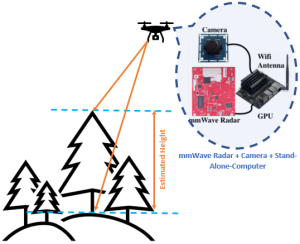
Figure 1: Scheme for height estimation
Explanation of the Research in Layperson’s Terms
The plant/tree generally reflects radio waves and other signals, and this reflection depends on the density of the forest. If a suitable signal processing is applied to the reflected signals, it will provide insight information about the forest profile. Nevertheless, this will help in the quantification of land covered by trees, identifying the location of those trees. Consequently, the tree canopy assessments help in determining the amount and location of impervious cover.
Funding Agency and Amount Sanctioned
National Scientific Research and Advanced Studies Program (PROCIENCIA) of the National Council for Science, Technology and Technological Innovation (CONCYTEC), Peru.
In Spanish: “ Programa Nacional de Investigación Cientifica y Estudios Avanzados (PROCIENCIA), del Consejo Nacional de Ciencia, Tecnología e Innovación
Tecnológica (CONCYTEC), Perú”.Practical Implementation of the Research or the Social Implications Associated with it
The proposed research work help will help in the assessment of deforestation as well as its impact on climate change and global warming. Not only this, but the research will also contribute to achieving carbon neutrality by 2050!
Collaborations
Universidad Nacional Tecnológica de Lima Sur
Collaborator: Prof. Mark Clement ArenasFuture Research Plans
In future, this work will be extended for infrastructure monitoring. With the boom in real estate, a continuous monitoring system is desired for proper maintenance.
Continue reading → - Dr Jaidev Kaushik’s Publishes New Publication on Graphene Incorporated Aerogels September 24, 2024
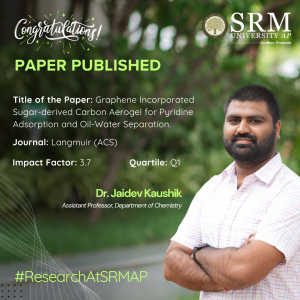 Dr Jaidev Kaushik, an Assistant Professor in the Department of Chemistry, has recently published a pioneering research paper in the prestigious journal Langmuir (ACS). The paper, titled “Graphene Incorporated Sugar-derived Carbon Aerogel for Pyridine Adsorption and Oil-Water Separation,” explores innovative applications of graphene-based materials.
Dr Jaidev Kaushik, an Assistant Professor in the Department of Chemistry, has recently published a pioneering research paper in the prestigious journal Langmuir (ACS). The paper, titled “Graphene Incorporated Sugar-derived Carbon Aerogel for Pyridine Adsorption and Oil-Water Separation,” explores innovative applications of graphene-based materials.Dr Kaushik’s research focuses on the development of a novel carbon aerogel derived from sugar and incorporated with graphene. This material demonstrates exceptional efficiency in adsorbing pyridine, a harmful organic compound, and effectively separating oil from water. These findings hold significant promise for environmental remediation and industrial applications, offering a sustainable solution to pollution and waste management challenges.
The publication of this paper in Langmuir highlights the cutting-edge research being conducted at SRM University-AP and underscores Dr Kaushik’s contributions to the field of chemistry. His work not only advances scientific understanding but also paves the way for practical applications that can benefit society at large.
Abstract
In this report, we have synthesized three-dimensional and hydrophobic graphene-incorporated carbon aerogel (G-SCA) derived from sugar. G-SCA is being used as a multifunctional sorbent material for removing various advanced water soluble and insoluble pollutants Initially, G-SCA is being explored for the adsorption of nitrophenols, nitroaromatics (3-nitroaniline), insecticide (Phoskill), antibiotic (ciprofloxacin), and pharmaceutical drug precursor (pyridine). Later, same G-SCA is also explored in the absorption of various protic and aprotic organic solvents and oils (including crude oil, waste cooking oil, and waste Mobil oil), with excellent recyclability checked up to 10 cycles. Moreover, oil-water separation experiments are also being done in various industrial wastewater samples and seawater to support the real-life accessibility of present approach. Large-scale applicability of G-SCA is also checked by performing crude oil-seawater separation experiments using a laboratory-scale prototype demonstrating the successful continuous recovery of crude oil.
Explanation of The Research in Layperson’s Terms
This research demonstrates the synthesis of carbon aerogel from edible sugar followed by the incorporation of graphene oxide to make a near superhydrophobic and good water-floating sorbent material. Later, this sorbent material was used to decontaminate wastewater from advanced pollutants such as explosive wastes, expired antibiotics, pharmaceutical waste, insecticides, etc. This report also showed the practical demonstration of crude oil recovery from seawater, thus contributing to the circular economy process.
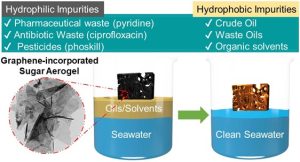
Title of Research Paper in the Citation Format
F. Agrawal, K. Gupta, J. Kaushik, K. M. Tripathi, S. K. Choudhary, S. K. Sonkar, Graphene Incorporated Sugar Derived Carbon Aerogel for Pyridine Adsorption and Oil–Water Separation, Langmuir 2024, 40, 18028–18038.
Practical Implementation or the Social Implications Associated with the Research
This work describes the synthesis of low-cost near superhydrophobic carbon aerogel, displaying its multiple applications in wastewater treatment from water-soluble and water-insoluble pollutants. It is also an alternative and cost-effective approach for recovering valuable oil and organic compounds from water rather than degrading or destroying them so they can be reused.
Collaborations
Dr Sumit Kumar Sonkar (MNIT Jaipur, India)
Future Research Plans
1. The adsorption/photodegradation-assisted quick and efficient removal of next generation advanced pollutants such as microplastic, pesticides, pharmaceutical waste, etc. by hydrophobic carbon aerogel and their doped and functionalised versions.
Continue reading →
2. Utilizing waste derived heterogeneous catalysts in organic transformation reactions.
3. Selective sensing of toxic metal ions/biomarkers/biomolecules using fluorescent nanomaterials.
4. Upcycling of carbonates/CO2 via photo/thermal assisted reactions to get C1 and C2 hydrocarbons (green fuel). - Unveiling Innovations: Dr Ghosh Publishes Findings on 300 GHz Communication Links September 24, 2024
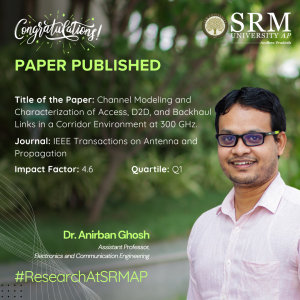 Dr Anirban Ghosh, an esteemed Assistant Professor in the Department of Electronics and Communication Engineering, has recently published a significant research paper titled “Channel Modeling and Characterization of Access, D2D, and Backhaul Links in a Corridor Environment at 300 GHz.” This paper has been featured in the prestigious Q1 Journal, IEEE Transactions on Antenna and Propagation, with an impressive impact factor of 4.6.
Dr Anirban Ghosh, an esteemed Assistant Professor in the Department of Electronics and Communication Engineering, has recently published a significant research paper titled “Channel Modeling and Characterization of Access, D2D, and Backhaul Links in a Corridor Environment at 300 GHz.” This paper has been featured in the prestigious Q1 Journal, IEEE Transactions on Antenna and Propagation, with an impressive impact factor of 4.6.
Dr Ghosh’s research delves into the intricate aspects of channel modelling and characterisation, focusing on access, device-to-device (D2D), and backhaul links within a corridor environment at a high frequency of 300 GHz. This study is poised to make substantial contributions to the field of wireless communication, particularly in enhancing the understanding and development of next-generation communication systems.
The publication in such a renowned journal underscores the quality and impact of Dr. Ghosh’s work, reflecting the cutting-edge research being conducted at SRM University – AP. The university community extends its heartfelt congratulations to Dr. Ghosh for this remarkable achievement and looks forward to his continued contributions to the field of electronics and communication engineering.Abstract:
This paper presents comprehensive double-directional channel measurements at 300 GHz across various corridor scenarios, including Access, Device-to-Device (D2D), and Backhaul, using an in-house developed channel sounder. The measurements, validated by ray tracing simulations, reveal that while 300 GHz quasi-optical propagation in corridors can be modeled using ray optics, non-trivial propagation phenomena, such as quadruple-bounce reflections, also occur. To accurately model these mechanisms, a quasi-deterministic (QD) channel model combining deterministic and random components is proposed. The QD model results align well with observations, highlighting similar propagation mechanisms for Access and D2D scenarios, while Backhaul scenarios show Line-of-Sight (LoS) impacts from ceiling reflections. These findings are crucial for designing next-generation THz communication systems.
Explanation of Research in Layperson’s Terms
This research contributes to building the next generation of communication networks, which will significantly impact society by improving connectivity, supporting technological advancements, and promoting economic development, and bringing forth several futuristic applications.
Practical Implementation
The results align with the design of high-frequency ultra-high speed, low-latency, reliable communication envisioned for several futuristic applications using beyond 5G and 6G networks.

The measurement scenarios explored in the paper.
Collaborations
Prof. Minseok Kim
Professor, Faculty of Engineering, Course of Electrical and Electronics Engineering
Niigata University, Japan.
e-mail: mskim@eng.niigata-u.ac.jpFuture Research Plans
The efforts would be extended to other communication scenarios for a similar study. Additionally, generating appropriate channel models, coverage design, link budget, etc for the explored and unexplored scenarios would also encompass an interesting study.
Continue reading → - Leadership Insights: Navigating the Future with Paari School of Business September 18, 2024
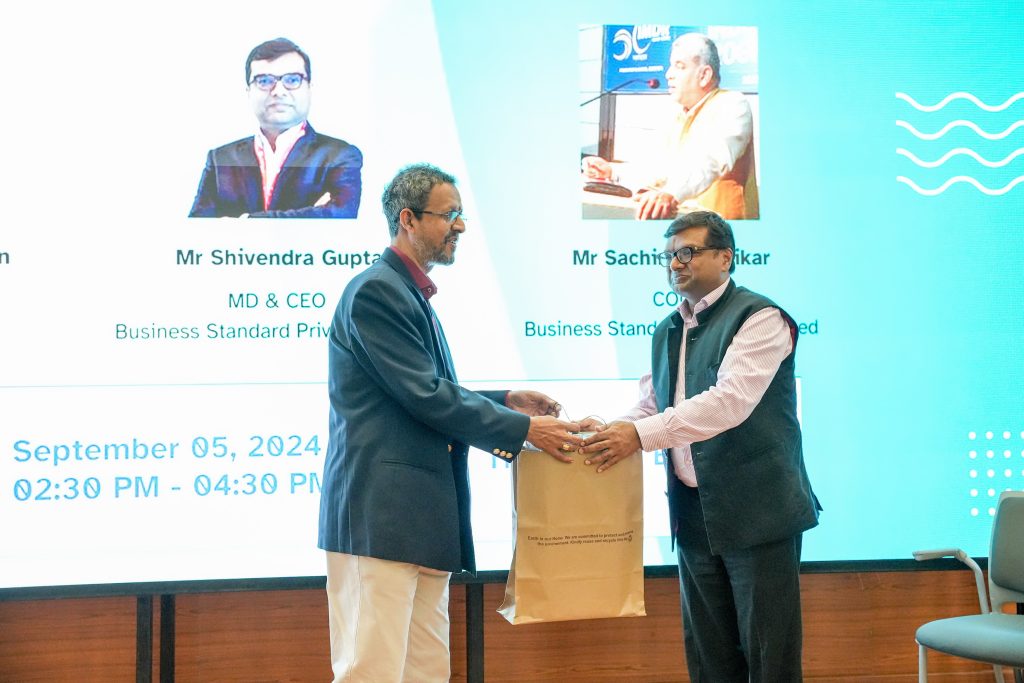 Paari School of Business’s “Insights and Perspectives” initiative featured an interactive discussion with three domain experts: Prof. Bharadhwaj Sivakumaran, Dean of PSB; Mr Shivendra Gupta, MD & CEO of Business Standard Private Ltd; and Mr Sachin Phaniskar, Chief Operating Officer of Business Standard Private Ltd, engaging with luminaries.
Paari School of Business’s “Insights and Perspectives” initiative featured an interactive discussion with three domain experts: Prof. Bharadhwaj Sivakumaran, Dean of PSB; Mr Shivendra Gupta, MD & CEO of Business Standard Private Ltd; and Mr Sachin Phaniskar, Chief Operating Officer of Business Standard Private Ltd, engaging with luminaries.The event aimed to offer practical leadership guidance and valuable insights for professional development from experienced personnel in the academic and corporate sectors. The initiative facilitated discussions with prominent figures to emphasise the importance of improving decision-making skills, interpersonal abilities, and technological proficiency. Participants were urged to seize opportunities for growth, leverage their strengths, work on areas needing improvement, and adopt a forward-thinking mindset. Additionally, the conversation highlighted key leadership principles, including effective delegation, creating a lasting impact, and turning challenges into strategic advantages.
Participants were also encouraged to focus on long-term goals, experience the complete lifecycle of projects, and understand the value of delegation and legacy-building in leadership. The conversation highlighted key themes such as turning challenges into opportunities, understanding the difference between ideation and business execution, and the importance of humility in achieving success. Overall, the event provided attendees with practical takeaways to apply in their leadership journey and a deeper understanding of the evolving demands in today’s business landscape.
Continue reading → - MoU Signed with Programming Hub for Launching AI-Powered Marketing Programme September 18, 2024
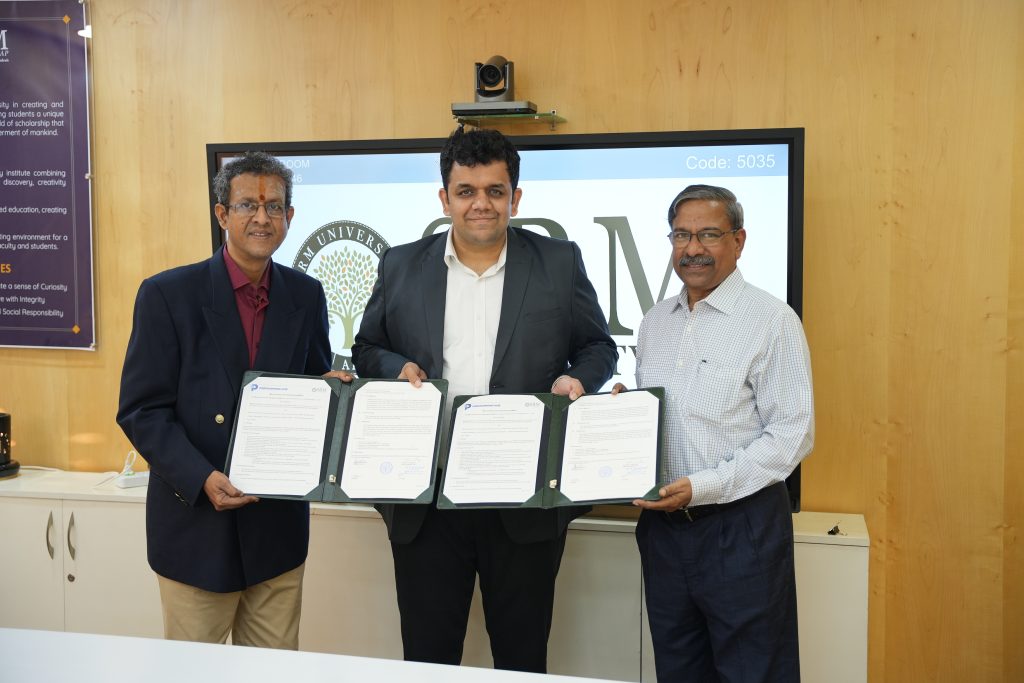
SRM University-AP inks an MoU with the EdTech Company, Programming Hub, to explore the possibility of integrating AI-powered marketing into the academic curriculum, facilitating a new age of empowered marketers. The MoU was signed by Mr Siddhesh Joglekar, CEO of Programming Hub, and Dr R Premkumar, Registrar, in the presence of Prof. Bharadhwaj Sivakumaran, Dean – Paari School of Business and the faculty of the school.
The MoU between the two organisations will assimilate AI-powered Marketing into the teaching pedagogy of the business programmes offered at Paari School of Business to bridge the gap between academia and industry. The association will also ensure the launch of AI-powered marketing programmes at Paari School of Business for prospective students in collaboration with Programming Hub. The partnership will also launch a 120-hour part-time weekend-only world-class certification programme in AI and Marketing.
“With marketing becoming an all-encompassing and essential aspect of business, AI will be the catalyst that supercharges the field of marketing, further boosting businesses into national and international domains. With AI as the key tool, marketing will be the intersection of various domains of science, technology, humanities, entrepreneurship and management”, stated Mr Siddhesh Joglekar, elucidating on the significance of AI-powered marketing on the current business landscape.
Prof. Bharadhwaj Sivakumaran, Dean of Paari School of Business, commented on this constructive collaboration, which will revolutionise the face of marketing in India. “By integrating AI-powered marketing with human-powered marketing, the pace of marketing will swiftly change, shifting students from skilled marketers to skilled decision makers. The AI-powered marketing programme will provide students with the ability to adapt and use AI in diverse ecosystems,” remarked Prof. Bharadhwaj.
With AI revolutionising all realms of management, from media planning and marketing research to customer service and sales marketing, AI-powered marketing can supplement human resources to boost their strategies and guarantee quality results within a short amount of time. SRM University-AP and its management precinct, Paari School of Business, continue to expand their network, fostering collaborations with reputed companies to provide their students with innovative and constructive programmes that will make them the powerhouse of the future.
Continue reading → - A Thought-Provoking Session with Megha Thapar September 18, 2024
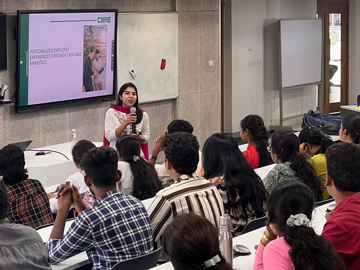 The Management precinct of the Paari School of Business had the honour of hosting an engrossing guest lecture, graced by Ms Megha Thapar, a distinguished Senior Associate Director – DEI. With an extensive 15-year career that spans the Financial Services, Retail, and Real Estate industries, Ms Thapar is renowned for her expertise in Diversity, Equity, and Inclusion (DEI). She brought invaluable insights and experiences to the forefront of this lecture, titled “Personalised Employee Experiences through Data and Analysis,” on August 21, 2024.
The Management precinct of the Paari School of Business had the honour of hosting an engrossing guest lecture, graced by Ms Megha Thapar, a distinguished Senior Associate Director – DEI. With an extensive 15-year career that spans the Financial Services, Retail, and Real Estate industries, Ms Thapar is renowned for her expertise in Diversity, Equity, and Inclusion (DEI). She brought invaluable insights and experiences to the forefront of this lecture, titled “Personalised Employee Experiences through Data and Analysis,” on August 21, 2024.The primary goal of this session was to enlighten both management students and professionals on the transformative power of data and analytics in crafting personalised employee experiences. Emphasising the critical role of DEI in the workplace, the lecture aimed to showcase how organisations could utilise data to foster more inclusive and high-performing environments. This focus was rooted in the belief that understanding and leveraging data can lead to more equitable and effective organisational practices.
Throughout the event, attendees were engaged with a series of case studies, demonstrating the practical application of data in addressing real-world HR challenges. These included analysing and interpreting key metrics to create significant business impacts. Ms Thapar guided the audience through the intricacies of identifying actionable data, extracting meaningful insights, and implementing strategies that not only enhance employee satisfaction but also bolster organisational efficiency.
The session was instrumental in equipping participants with the critical thinking skills necessary for making informed, data-driven decisions. By delving deep into how data and analytics can revolutionise the employee experience, the lecture illuminated the pathways to advancing DEI initiatives within various organisational settings. Attendees were encouraged to apply the knowledge gleaned from the case studies shared by Ms Thapar, thereby learning to employ data-driven strategies in nurturing an inclusive workplace culture, boosting employee engagement, and aligning with broader organisational objectives.
As the lecture concluded, the outcomes were profoundly impactful. Participants left with a deeper understanding of the role of data in transforming employee experiences and driving DEI efforts. They gained practical knowledge on leveraging data to tackle real-world HR and DEI challenges effectively. Furthermore, the insights into interpreting data, understanding employee behavior, and identifying actionable insights empowered them to initiate meaningful changes within their organisations. Armed with these skills, they are now better positioned to weave DEI principles into their organisational fabric, using data to tailor solutions and foster a more inclusive, equitable work environment. This event not only highlighted the critical importance of analytics in creating dynamic, authentic, and diverse teams but also fostered a greater appreciation for the strategic use of data in achieving high-performance organisational outcomes.
Continue reading → - A Helping Hand: Pro-Chancellor Donate Rs. 3 crores to CM’s Flood Relief Fund September 14, 2024
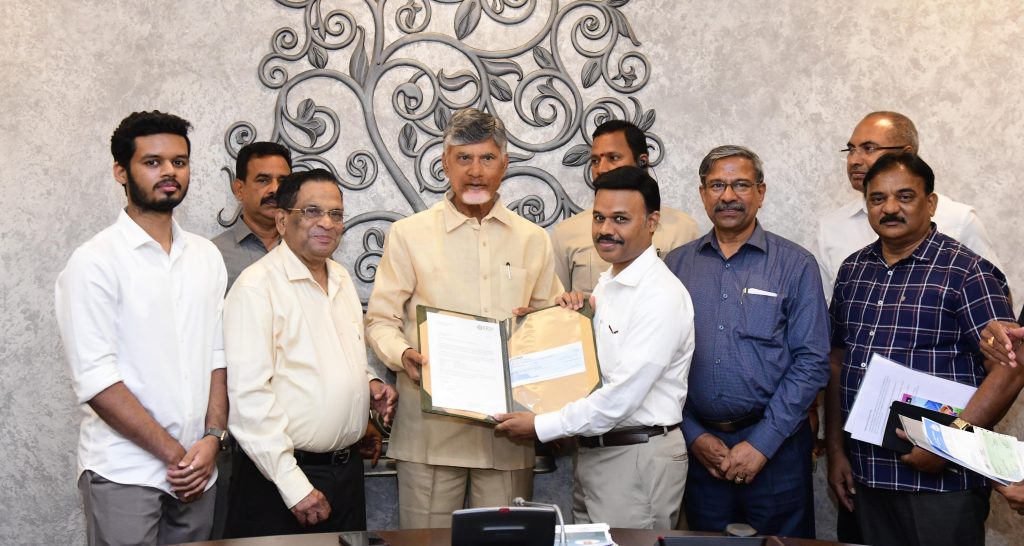
Pro-Chancellor of SRM University-AP, Dr P Sathyanarayanan, has contributed Rs. 3 crores as financial aid to the Chief Minister’s Relief Fund to help rehabilitate and reconstruct the drastically affected areas by the recent floods. The leadership team of the university, including Trustee Shri Balaji Sathyanarayanan, Executive Research Head of SRM Group Prof. D Narayana Rao and Registrar Dr R Premkumar, handed over the cheque to the honourable Chief Minister of the state Shri Nara Chandrababu Naidu at the AP Secretariat.
“It is in the very fabric of humankind to help others who are in need of safety, security and shelter. We at SRM University-AP stand with the state of Andhra Pradesh at this dire hour and will extend our extensive support towards the rehabilitation projects”, stated Dr Sathyanarayanan. Honourable CM Shri Nara Chandrababu Naidu expressed his gratitude for the magnanimous contribution of the university patron.
SRM University-AP also distributed food parcels and other amenities to the flood victims. The distribution program was initiated by Pro-Chancellor Dr P Sathyanarayanan and conducted under the aegis of the Vice Chancellor of the university, Prof. Manoj K Arora. Food packets worth Rs.10 lakh, water bottles, fruits, bread and biscuits were distributed in Gollapudi, Singh Nagar and Vambay Colony areas of Vijayawada.
Continue reading →


